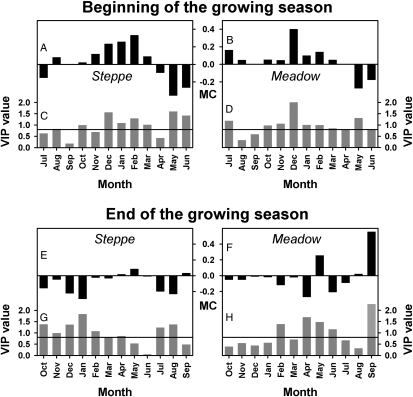Fig. 4.
Response of the BGS (A–D) and EGS (E–H) in steppe and meadow vegetation of the Tibetan Plateau between 1982 and 2006 to monthly temperatures, according to PLS regression. For the BGS, the variable importance plots (VIP; C and D) indicate that temperatures in both spring (May and June) and winter (October through March) were important for explaining the response of BGS dates (VIP values above 0.8). Model coefficients (MC) of the centered and scaled data showed that warm winter temperatures delayed spring phenology (positive coefficients), whereas warm spring temperatures advanced the BGS (negative coefficients) for both steppe (A) and meadow (B). Including both effects into phenological models could substantially enhance our understanding of climate-change effects on vegetation at temperate and cold locations. For the EGS in the steppe region, the VIP (G) indicates that temperatures during most months contributed to explaining the variation in EGS dates. MC values (E) showed that warm temperatures in all of the important months contributed to an advance of the EGS date. This finding indicates that additional heat allows plants to complete their growth cycle earlier rather than extending the period, during which vegetation is active. EGS dates of meadow vegetation were mainly determined by temperatures in spring and September (H). Although temperature influence in spring is somewhat inconsistent (F), warm conditions in September delay the EGS date. In contrast to steppe, meadow vegetation can thus make use of the extended period of favorable conditions.

